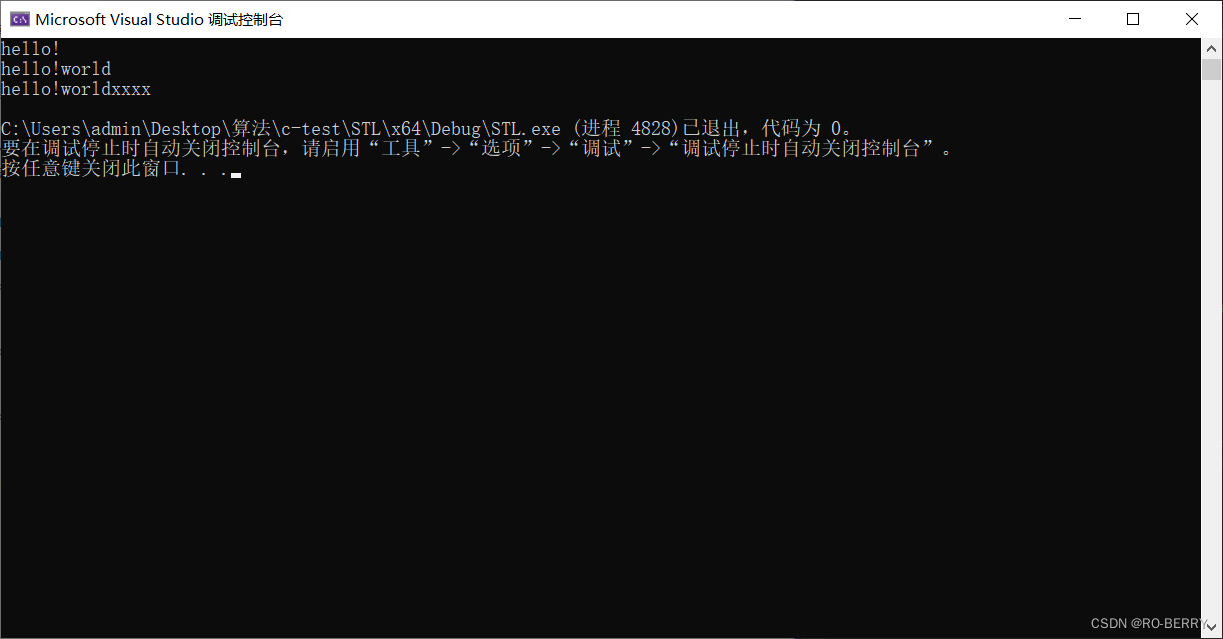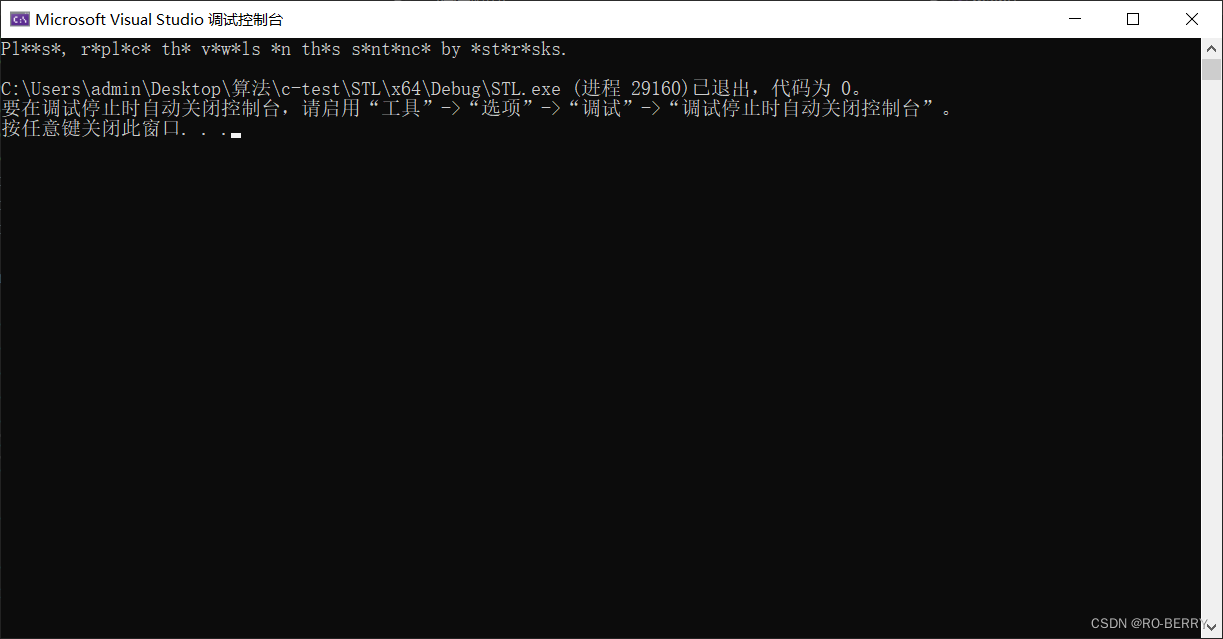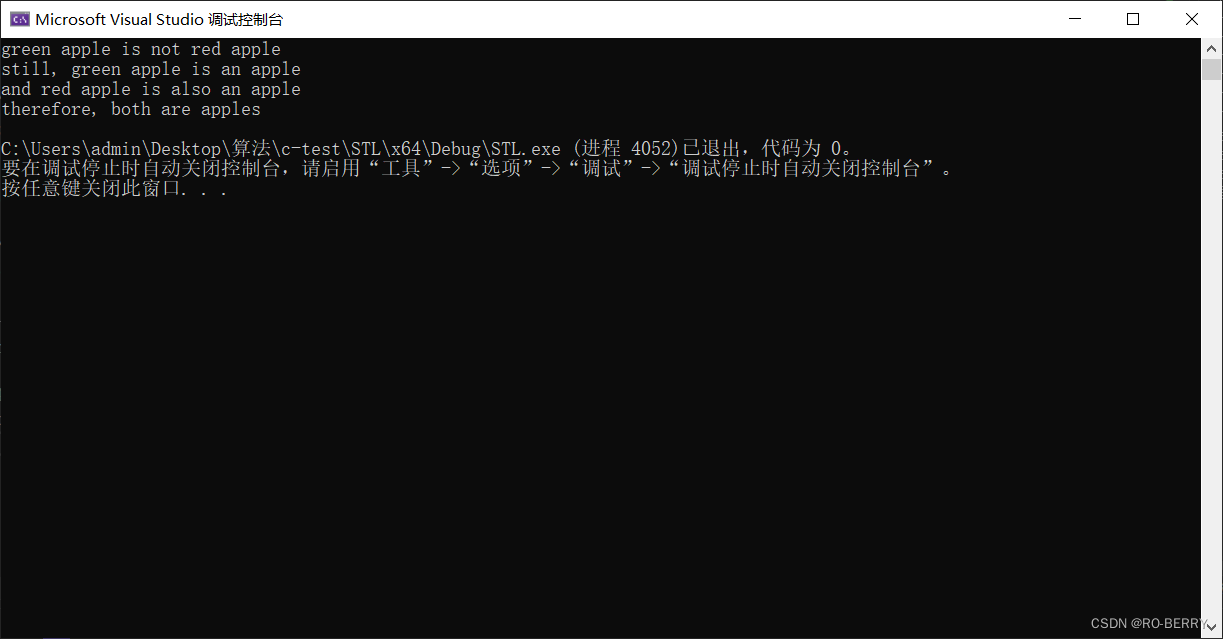 ?你好,我是 RO-BERRY ? 致力于C、C++、数据结构、TCP/IP、数据库等等一系列知识 ?感谢你的陪伴与支持 ,故事既有了开头,就要画上一个完美的句号,让我们一起加油
?你好,我是 RO-BERRY ? 致力于C、C++、数据结构、TCP/IP、数据库等等一系列知识 ?感谢你的陪伴与支持 ,故事既有了开头,就要画上一个完美的句号,让我们一起加油 
目录
前言?push_back接口?append接口?operator+= (重点)?replace接口?find接口?npos?find + npos(重点)?substr?insert接口?erase接口?refind接口?c_str接口?find_first_of接口?compare接口总结
前言
| 函数名称 | 功能说明 |
|---|---|
| push_back | 在字符串后尾插字符c |
| append | 在字符串后追加一个字符串 |
| operator+= (重点) | 在字符串后追加字符串str |
| c_str(重点) | 返回C格式字符串 |
| find + npos(重点) | 从字符串pos位置开始往后找字符c,返回该字符在字符串中的位置 |
| rfind | 从字符串pos位置开始往前找字符c,返回该字符在字符串中的位置 |
| substr | 在str中从pos位置开始,截取n个字符,然后将其返回 |
?push_back接口
int main(){string str;str.push_back(' '); // 在str后插入空格str.append("hello"); // 在str后追加一个字符"hello"str += 'w'; // 在str后追加一个字符'w' str += "xxx"; // 在str后追加一个字符串"xxx"cout << str << endl;cout << str.c_str() << endl; // 以C语言的方式打印字符串return 0;}
?append接口
append()是一个成员函数,用于将字符串或字符序列添加到当前字符串的末尾。它有多种重载形式,可以接受不同类型的参数。

这里其实用第一个就已经足够了,其他的显的有些多余
int main(){string s1("hello");s1.append("abcd");cout << s1 << endl;return 0;}
string str = "Hello";char arr[] = " World";str.append(arr);// 现在str的值为"Hello World"string str = "Hello";char ch = '!';int repeatCount = 3;str.append(repeatCount, ch);// 现在str的值为"Hello!!!"4.如果传入字符串的头和尾作为参数,它会将该字符添加到当前字符串的末尾
int main(){string s1("hello");s1.append("abcd");cout << s1 << endl;//在s2后面加入s1string s2 = "xxxx";s2.append(s1.begin(), s1.end());cout << s2 << endl;return 0;}?operator+= (重点)
int main(){//最简便的方式string s1("hello");string s2 = "xxxx";s1 += '!';cout << s1 << endl;s1 += "world";cout << s1 << endl;s1 += s2;cout << s1 << endl;return 0;}
?replace接口
string容器的replace接口用于替换字符串中的一部分内容。它有多个重载形式,可以根据需要进行不同的替换操作。
replace(pos, count, str):将从位置pos开始的count个字符替换为字符串str。示例:string str = “Hello, world!”;
str.replace(7, 5, “CSDN”);
替换后的字符串为:“Hello, CSDN!”
replace(pos, count, str, pos2, count2):将从位置pos开始的count个字符替换为字符串str中从位置pos2开始的count2个字符。示例:string str = “Hello, world!”;
string str2 = “CSDN”;
str.replace(7, 5, str2, 0, 4);
替换后的字符串为:“Hello, CSDN!”
replace(iterator1, iterator2, str):将迭代器iterator1和iterator2之间的字符替换为字符串str。示例:string str = “Hello, world!”;
string str2 = “CSDN”;
str.replace(str.begin() + 7, str.begin() + 12, str2);
替换后的字符串为:“Hello, CSDN!”
replace(iterator1, iterator2, iterator3, iterator4):将迭代器iterator1和iterator2之间的字符替换为迭代器iterator3和iterator4之间的字符。示例:string str = “Hello, world!”;
string str2 = “CSDN”;
str.replace(str.begin() + 7, str.begin() + 12, str2.begin(), str2.end());
替换后的字符串为:“Hello, CSDN!”
?find接口
string容器的find接口用于在字符串中查找指定的子串,并返回其第一次出现的位置。该接口有多个重载形式,可以根据需要选择使用。
find(const string& str, size_t pos = 0) const:在字符串中从指定位置pos开始查找子串str,并返回其第一次出现的位置。如果找不到,则返回string::npos。
find(const char* s, size_t pos = 0) const:在字符串中从指定位置pos开始查找C风格字符串s,并返回其第一次出现的位置。如果找不到,则返回string::npos。
find(char c, size_t pos = 0) const:在字符串中从指定位置pos开始查找字符c,并返回其第一次出现的位置。如果找不到,则返回string::npos。
其中,pos参数表示查找的起始位置,默认为0,即从字符串的开头开始查找。
?npos
string::npos是C++中string类的一个静态成员变量,它表示一个无效的或者不存在的位置。在string类中,npos的值是一个特殊的常量,通常被用来表示字符串中某个字符或子串不存在的情况。
当我们在使用string类的成员函数进行查找操作时,如果没有找到指定的字符或子串,那么返回值就会是npos。这个值在不同的编译器中可能会有所不同,但通常它的值是-1或者一个非法的索引值。
使用npos可以方便地判断字符串中是否包含某个字符或子串。
?find + npos(重点)
int main(){string s1("hello world hello world");cout << s1 << endl;//将所有的空格替换成20%size_t pos = s1.find(' ');while (pos != string::npos){s1.replace(pos, 1, "%20"); //replace效率是特别低的最好不要用pos = s1.find(' ');}cout << s1 << endl;return 0;}
?substr
substr是一种字符串操作函数,用于从一个字符串中提取子字符串。它的语法如下:string substr (size_t pos, size_t len) const;
其中,pos表示要提取的子字符串的起始位置,len表示要提取的子字符串的长度。返回值是一个新的字符串,包含了从原始字符串中提取的子字符串。
获取file的后缀
int main() {string file("string.cpp");size_t pos = file.rfind('.');string suffix(file.substr(pos, file.size() - pos)); //取后缀并拷贝构造suffixcout << suffix << endl;return 0;}
取出url中的域名
int main() {string url("http://www.cplusplus.com/reference/string/string/find/");cout << url << endl;size_t start = url.find("://");if (start == string::npos){cout << "invalid url" << endl;return 1;}start += 3;size_t finish = url.find('/', start);string address = url.substr(start, finish - start);cout << address << endl;return 0;}
?insert接口
string容器的insert接口用于在指定位置插入字符或字符串。它有多个重载形式,具体取决于插入的内容和位置。
insert(pos, str):在指定位置pos前插入字符串str。示例:
str.insert(3, "hello") 将在索引为3的位置前插入字符串"hello"。 2. insert(pos, str, subpos, sublen):在指定位置pos前插入字符串str的子串,子串的起始位置为subpos,长度为sublen。
示例:str.insert(5, "world", 2, 3) 将在索引为5的位置前插入字符串"wor"。
insert(pos, n, ch):在指定位置pos前插入字符ch的副本,重复插入n次。示例:
str.insert(2, 3, 'a') 将在索引为2的位置前插入3个字符’a’。 ?erase接口
string容器的erase接口用于删除指定位置的字符或者一段字符。它有两种重载形式:
erase(pos, count):删除从位置pos开始的count个字符。其中,pos是一个索引值,表示要删除的起始位置;count是要删除的字符数量。
erase(iterator first, iterator last):删除从迭代器first指向的字符开始,到迭代器last指向的字符之前的所有字符。其中,first和last是迭代器,表示要删除的字符范围。
需要注意的是,erase操作会改变原始字符串,删除指定位置的字符后,后面的字符会自动向前移动。
?refind接口
与find()函数类似,但是从字符串的末尾开始查找子串
size_t refind(const string& str, size_t pos = 0) const;
其中,str是要查找的子串,pos是查找的起始位置,默认为0。该函数返回子串第一次出现的位置,如果找不到则返回string::npos。
使用示例:
#include <iostream>#include <string>using namespace std;int main() {string str = "Hello, world!";string subStr = "world";size_t pos = str.find(subStr);if (pos != string::npos) {cout << "子串 \"" << subStr << "\" 在字符串 \"" << str << "\" 中的位置是:" << pos << endl;}else {cout << "未找到子串 \"" << subStr << "\" 在字符串 \"" << str << "\" 中" << endl;}return 0;}
?c_str接口
c_str()是C++中的一个字符串成员函数,用于返回一个指向以null结尾的字符数组(C风格字符串)的指针。它通常用于将C++的std::string对象转换为C风格字符串。
使用c_str()函数可以方便地将std::string对象传递给需要C风格字符串作为参数的函数或接口。
例如,如果你有一个std::string对象str,你可以通过调用str.c_str()来获取一个指向以null结尾的字符数组的指针。
需要注意的是:c_str()返回的指针指向的字符数组是只读的,不能修改其中的内容。如果需要修改字符串内容,应该使用其他方法。
?find_first_of接口
string容器的find_first_of()函数是用于在字符串中查找第一个与指定字符序列中的任何字符匹配的字符的位置。它的语法如下:
size_t find_first_of(const string& str, size_t pos = 0) const noexcept;其中,str是要查找的字符序列,pos是开始查找的位置,默认为0。
该函数返回一个size_t类型的值,表示找到的字符的位置。如果未找到匹配的字符,则返回string::npos。
该函数会从字符串的pos位置开始逐个字符地与str中的字符进行匹配,直到找到第一个匹配的字符或者到达字符串的末尾。
将语句中的“aeiou”全部替换成“ * ”
#include <iostream> // std::cout#include <string> // std::string#include <cstddef> // std::size_tint main(){std::string str("Please, replace the vowels in this sentence by asterisks.");std::size_t found = str.find_first_of("aeiou");while (found != std::string::npos){str[found] = '*';found = str.find_first_of("aeiou", found + 1); }std::cout << str << '\n';return 0;}
?compare接口
string容器的compare()函数是用于比较两个字符串的。它返回一个整数值,表示两个字符串的大小关系。
compare()函数有以下几种用法:
1. compare(str):将当前字符串与参数str进行比较。返回值为0表示两个字符串相等,返回值大于0表示当前字符串大于参数str,返回值小于0表示当前字符串小于参数str。
2. compare(pos, len, str):从当前字符串的位置pos开始,比较长度为len的子串与参数str进行比较。返回值的含义与上述相同。
3. compare(pos, len, str, subpos, sublen):从当前字符串的位置pos开始,比较长度为len的子串与参数str的子串(从subpos开始,长度为sublen)进行比较。返回值的含义与上述相同。
注意,compare()函数是区分大小写的,即大写字母和小写字母被认为是不同的字符。
#include <iostream>#include <string>int main(){std::string str1("green apple");std::string str2("red apple");if (str1.compare(str2) != 0)std::cout << str1 << " is not " << str2 << '\n';if (str1.compare(6, 5, "apple") == 0)std::cout << "still, " << str1 << " is an apple\n";if (str2.compare(str2.size() - 5, 5, "apple") == 0)std::cout << "and " << str2 << " is also an apple\n";if (str1.compare(6, 5, str2, 4, 5) == 0)std::cout << "therefore, both are apples\n";return 0;}
总结
在这里只是着重进行了string容器的常用接口的介绍以及使用,更多的接口还需要去查阅,修行之路还很漫长,让我们共同努力